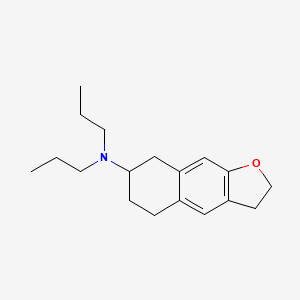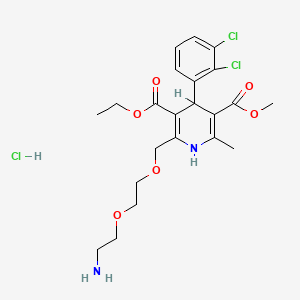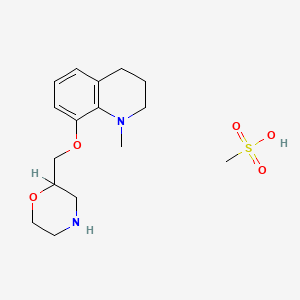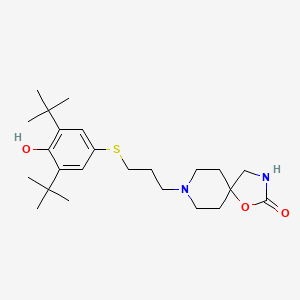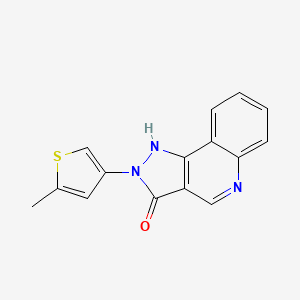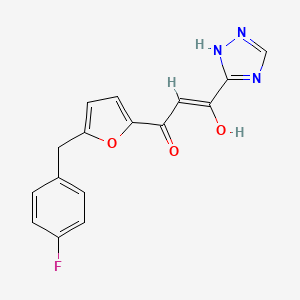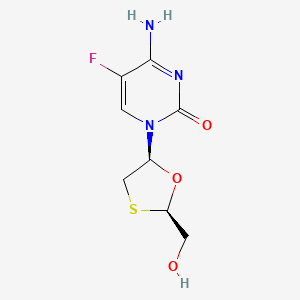
Emtricitabina
Descripción general
Descripción
Emtricitabine, with the systematic name 2’,3’-dideoxy-5-fluoro-3’-thiacytidine, is a nucleoside reverse-transcriptase inhibitor used primarily for the prevention and treatment of human immunodeficiency virus (HIV) infection in adults and children . It is also known by its trade name, Emtriva. Emtricitabine is a synthetic analogue of cytidine and is effective against both HIV and hepatitis B virus (HBV) .
Mecanismo De Acción
Target of Action
Emtricitabine, a nucleoside reverse transcriptase inhibitor (NRTI), primarily targets the HIV-1 reverse transcriptase enzyme . This enzyme plays a crucial role in the life cycle of the HIV virus, as it is responsible for transcribing the viral RNA into DNA .
Mode of Action
Emtricitabine works by inhibiting the HIV-1 reverse transcriptase enzyme . It is a cytidine analogue that, once phosphorylated to emtricitabine 5’-triphosphate, competes with the natural substrate deoxycytidine 5’-triphosphate for incorporation into the developing viral DNA strand . As the enzyme incorporates emtricitabine into the forming DNA strands, new nucleotides are unable to be incorporated, leading to the termination of the viral DNA chain .
Biochemical Pathways
Emtricitabine interferes with the HIV-1 reverse transcriptase enzyme, which is a key player in the viral replication process . By inhibiting this enzyme, emtricitabine prevents the transcription of HIV RNA to DNA, thereby disrupting the viral replication cycle and reducing the number of viruses in the body .
Pharmacokinetics
Emtricitabine exhibits high bioavailability (93%) and is metabolized through hepatic oxidation and glucuronidation . It has a half-life of approximately 10 hours . The compound is eliminated primarily through renal excretion (86%) and to a lesser extent through fecal excretion (14%) . The renal clearance of emtricitabine is greater than the estimated creatinine clearance, suggesting elimination by both glomerular filtration and active tubular secretion .
Result of Action
The primary result of emtricitabine’s action is the reduction of HIV-1 viral load in the body . By inhibiting the reverse transcriptase enzyme and terminating the viral DNA chain, emtricitabine prevents the replication of the HIV-1 virus, thereby reducing the number of viruses in the body .
Action Environment
The efficacy and stability of emtricitabine can be influenced by various environmental factors. For instance, the presence of other antiretroviral agents can enhance the drug’s effectiveness when used in combination therapy . Additionally, patient-specific factors such as renal function can impact the drug’s pharmacokinetics . For example, patients with impaired renal function may have altered drug clearance, potentially requiring dose adjustments .
Aplicaciones Científicas De Investigación
Emtricitabine has a wide range of scientific research applications, including:
Chemistry: Used as a model compound for studying nucleoside analogues and their chemical properties.
Biology: Employed in research on viral replication and the mechanisms of antiviral agents.
Medicine: Extensively used in clinical research for the treatment and prevention of HIV and HBV infections.
Industry: Utilized in the development of antiretroviral therapies and fixed-dose combination drugs
Análisis Bioquímico
Biochemical Properties
Emtricitabine is a cytidine analogue . It interacts with the enzyme HIV reverse transcriptase, preventing the transcription of HIV RNA to DNA . This interaction is crucial in its role in biochemical reactions related to HIV infection.
Cellular Effects
Emtricitabine has significant effects on various types of cells, particularly those infected with HIV. It inhibits HIV reverse transcriptase, thereby preventing the transcription of HIV RNA to DNA within the cell . This can influence cell function, including impacts on cell signaling pathways, gene expression, and cellular metabolism .
Molecular Mechanism
Emtricitabine exerts its effects at the molecular level primarily through its inhibition of HIV reverse transcriptase . This prevents the transcription of HIV RNA to DNA, thereby inhibiting the replication of the virus within the cell .
Temporal Effects in Laboratory Settings
The effects of Emtricitabine over time in laboratory settings are largely related to its continued inhibition of HIV reverse transcriptase
Metabolic Pathways
Emtricitabine is metabolized through hepatic oxidation and glucuronidation . The cytochrome P450 system is not involved in its metabolism . A small portion of Emtricitabine is eliminated as sulfide and glucuronide metabolites .
Transport and Distribution
Emtricitabine is administered orally and has a bioavailability of 93%
Subcellular Localization
The subcellular localization of Emtricitabine is not explicitly stated in the available literature. Given its mechanism of action, it can be inferred that it interacts with HIV reverse transcriptase, an enzyme that is typically found in the cytoplasm of the cell .
Métodos De Preparación
Synthetic Routes and Reaction Conditions: Emtricitabine is synthesized through a multi-step process involving the following key steps:
Formation of the oxathiolane ring: This involves the reaction of a suitable sugar derivative with a thiol compound to form the oxathiolane ring.
Introduction of the fluorine atom: The fluorine atom is introduced at the 5-position of the pyrimidine ring through a fluorination reaction.
Coupling of the oxathiolane and pyrimidine rings: The oxathiolane ring is coupled with the fluorinated pyrimidine ring to form the final product.
Industrial Production Methods: Industrial production of emtricitabine involves large-scale synthesis using optimized reaction conditions to ensure high yield and purity. The process typically includes:
Bulk synthesis: Large quantities of starting materials are reacted under controlled conditions to form the intermediate compounds.
Purification: The intermediate compounds are purified using techniques such as crystallization and chromatography.
Final synthesis and formulation: The purified intermediates are reacted to form emtricitabine, which is then formulated into the final pharmaceutical product.
Análisis De Reacciones Químicas
Types of Reactions: Emtricitabine undergoes various chemical reactions, including:
Oxidation: Emtricitabine can be oxidized to form its corresponding sulfoxide and sulfone derivatives.
Reduction: Reduction reactions can convert emtricitabine back to its original form from its oxidized derivatives.
Substitution: Substitution reactions can occur at the fluorine atom or the amino group on the pyrimidine ring.
Common Reagents and Conditions:
Oxidation: Common oxidizing agents include hydrogen peroxide and peracids.
Reduction: Reducing agents such as sodium borohydride and lithium aluminum hydride are used.
Substitution: Substitution reactions often involve nucleophiles such as amines and thiols.
Major Products:
Oxidation: Sulfoxide and sulfone derivatives.
Reduction: Emtricitabine.
Substitution: Various substituted derivatives depending on the nucleophile used.
Comparación Con Compuestos Similares
- Lamivudine
- Zidovudine
- Tenofovir disoproxil
- Tenofovir alafenamide
Emtricitabine’s unique properties, such as its long half-life and high efficacy, make it a valuable component in antiretroviral therapy.
Propiedades
IUPAC Name |
4-amino-5-fluoro-1-[2-(hydroxymethyl)-1,3-oxathiolan-5-yl]pyrimidin-2-one | |
|---|---|---|
| Source | PubChem | |
| URL | https://pubchem.ncbi.nlm.nih.gov | |
| Description | Data deposited in or computed by PubChem | |
InChI |
InChI=1S/C8H10FN3O3S/c9-4-1-12(8(14)11-7(4)10)5-3-16-6(2-13)15-5/h1,5-6,13H,2-3H2,(H2,10,11,14) | |
| Source | PubChem | |
| URL | https://pubchem.ncbi.nlm.nih.gov | |
| Description | Data deposited in or computed by PubChem | |
InChI Key |
XQSPYNMVSIKCOC-UHFFFAOYSA-N | |
| Source | PubChem | |
| URL | https://pubchem.ncbi.nlm.nih.gov | |
| Description | Data deposited in or computed by PubChem | |
Canonical SMILES |
C1C(OC(S1)CO)N2C=C(C(=NC2=O)N)F | |
| Source | PubChem | |
| URL | https://pubchem.ncbi.nlm.nih.gov | |
| Description | Data deposited in or computed by PubChem | |
Molecular Formula |
C8H10FN3O3S | |
| Source | PubChem | |
| URL | https://pubchem.ncbi.nlm.nih.gov | |
| Description | Data deposited in or computed by PubChem | |
DSSTOX Substance ID |
DTXSID60861371 | |
| Record name | 4-Amino-5-fluoro-1-[2-(hydroxymethyl)-1,3-oxathiolan-5-yl]pyrimidin-2(1H)-one | |
| Source | EPA DSSTox | |
| URL | https://comptox.epa.gov/dashboard/DTXSID60861371 | |
| Description | DSSTox provides a high quality public chemistry resource for supporting improved predictive toxicology. | |
Molecular Weight |
247.25 g/mol | |
| Source | PubChem | |
| URL | https://pubchem.ncbi.nlm.nih.gov | |
| Description | Data deposited in or computed by PubChem | |
CAS No. |
143491-54-7 | |
| Record name | Racivir | |
| Source | DrugBank | |
| URL | https://www.drugbank.ca/drugs/DB12753 | |
| Description | The DrugBank database is a unique bioinformatics and cheminformatics resource that combines detailed drug (i.e. chemical, pharmacological and pharmaceutical) data with comprehensive drug target (i.e. sequence, structure, and pathway) information. | |
| Explanation | Creative Common's Attribution-NonCommercial 4.0 International License (http://creativecommons.org/licenses/by-nc/4.0/legalcode) | |
Retrosynthesis Analysis
AI-Powered Synthesis Planning: Our tool employs the Template_relevance Pistachio, Template_relevance Bkms_metabolic, Template_relevance Pistachio_ringbreaker, Template_relevance Reaxys, Template_relevance Reaxys_biocatalysis model, leveraging a vast database of chemical reactions to predict feasible synthetic routes.
One-Step Synthesis Focus: Specifically designed for one-step synthesis, it provides concise and direct routes for your target compounds, streamlining the synthesis process.
Accurate Predictions: Utilizing the extensive PISTACHIO, BKMS_METABOLIC, PISTACHIO_RINGBREAKER, REAXYS, REAXYS_BIOCATALYSIS database, our tool offers high-accuracy predictions, reflecting the latest in chemical research and data.
Strategy Settings
| Precursor scoring | Relevance Heuristic |
|---|---|
| Min. plausibility | 0.01 |
| Model | Template_relevance |
| Template Set | Pistachio/Bkms_metabolic/Pistachio_ringbreaker/Reaxys/Reaxys_biocatalysis |
| Top-N result to add to graph | 6 |
Feasible Synthetic Routes
Q1: How does emtricitabine inhibit the replication of Human Immunodeficiency Virus type 1?
A1: Emtricitabine, a synthetic nucleoside analog of cytidine, requires intracellular phosphorylation to its active triphosphate form, emtricitabine 5'-triphosphate. This active metabolite acts as a competitive inhibitor of the Human Immunodeficiency Virus type 1 (HIV-1) reverse transcriptase (RT) enzyme. It competes with the natural substrate deoxycytidine 5'-triphosphate for binding to the active site of the enzyme. Additionally, emtricitabine 5'-triphosphate gets incorporated into the nascent viral DNA, causing chain termination and halting further DNA synthesis. []
Q2: What is the significance of the M184V/I mutation in the context of emtricitabine resistance?
A2: The M184V/I mutation in the HIV-1 reverse transcriptase gene is the primary resistance mechanism against emtricitabine and lamivudine. [, ] This mutation confers high-level resistance to these drugs by altering the enzyme's binding site, hindering the incorporation of emtricitabine 5'-triphosphate into the viral DNA. [, ]
Q3: What is the chemical name and molecular formula of emtricitabine?
A3: Emtricitabine is chemically known as 5-fluoro-1-[(2R, 5S)-2-(hydroxymethyl)-1, 3-oxathiolan-5yl]cytosine. Its molecular formula is C8H10FN3O3S. []
Q4: Can you provide information regarding the spectroscopic characterization of emtricitabine?
A4: Emtricitabine exhibits maximum ultraviolet absorbance (λmax) at 260 nm when dissolved in methanol. [] Specific spectroscopic data, like infrared (IR) or nuclear magnetic resonance (NMR) spectra, are not provided in the reviewed research.
Q5: What is the role of the fluorine atom in the structure of emtricitabine for its activity?
A5: While the reviewed research doesn't directly address the specific role of the fluorine atom in emtricitabine, it's known that the fluorine substitution at the 5-position of the cytosine ring generally enhances the potency and metabolic stability of nucleoside analogs. This modification likely influences the binding affinity to the HIV-1 reverse transcriptase and reduces its susceptibility to degradation by cellular enzymes.
Q6: What are the common formulations of emtricitabine used in pharmaceutical dosage forms?
A7: Emtricitabine is commonly formulated as tablets, either as a single agent or in combination with other antiretroviral drugs. It is frequently combined with tenofovir disoproxil fumarate for the treatment of HIV-1 infection. [, , , , , , , ] Single-tablet regimens containing emtricitabine, tenofovir disoproxil fumarate, and a third antiretroviral drug, such as efavirenz, rilpivirine, or elvitegravir/cobicistat, are also widely available. [, , , , ]
Q7: How does emtricitabine's long intracellular half-life contribute to its efficacy?
A8: The intracellular half-life of emtricitabine triphosphate, the active form of the drug, is significantly longer than its plasma half-life. [] This prolonged intracellular persistence allows for effective inhibition of HIV-1 reverse transcriptase within infected cells, even with once-daily dosing. [, ]
Q8: How are emtricitabine concentrations measured in biological samples?
A10: Liquid chromatography coupled with tandem mass spectrometry (LC-MS/MS) is a commonly used method to quantify emtricitabine in various biological matrices, including plasma, breast milk, and dried blood spots. [, ]
Q9: What are the in vitro findings regarding the synergistic activity of emtricitabine with tenofovir disoproxil fumarate?
A11: In vitro studies have demonstrated a strong synergistic effect between emtricitabine and tenofovir disoproxil fumarate against HIV-1. [] This synergism is believed to contribute to the enhanced efficacy of the combination therapy compared to either drug alone.
Q10: Is emtricitabine effective against HIV-1 strains resistant to lamivudine?
A12: Emtricitabine and lamivudine share a similar resistance profile, particularly related to the M184V/I mutation. HIV-1 strains carrying this mutation are highly resistant to both drugs. [, ] Therefore, emtricitabine is generally not effective against HIV-1 strains already resistant to lamivudine.
Q11: What analytical methods are employed for the simultaneous estimation of emtricitabine and other antiretroviral drugs in pharmaceutical formulations?
A15: Several analytical methods have been developed for the simultaneous estimation of emtricitabine and other antiretroviral drugs in pharmaceutical dosage forms. High-performance liquid chromatography (HPLC) is the most widely used technique, often coupled with ultraviolet (UV) or diode-array detection (DAD). [, , , , , , , , , , ]
Q12: How are spectrophotometric methods used for emtricitabine analysis?
A16: Spectrophotometric methods can be employed for the determination of emtricitabine in bulk and pharmaceutical formulations. These methods typically involve the reaction of emtricitabine with a chromogenic reagent, such as p-Dimethylaminobenzaldehyde (PDAB) or 4-Hydroxy-3-methoxy benzaldehyde (HMBA) in the presence of dilute sulphuric acid, to form colored products measurable at specific wavelengths. []
Q13: What were the key milestones in the development of emtricitabine as an anti-HIV drug?
A17: The development of emtricitabine spanned two decades, beginning with its synthesis and initial anti-HIV activity evaluation in the early 1990s. [] Key milestones include:
- 1990: Diastereoselective synthesis of racemic emtricitabine and demonstration of potent anti-HIV activity. []
- 1996: Triangle Pharmaceuticals licenses emtricitabine and initiates clinical trials. []
- 1998: Emtricitabine receives "Fast Track" status from the FDA for its potential for once-daily dosing. []
- 2003: Gilead Sciences acquires Triangle Pharmaceuticals and completes the development of emtricitabine (emtricitabine), which is approved for once-a-day oral administration. []
- 2004: Truvada, a fixed-dose combination of emtricitabine and tenofovir disoproxil fumarate, receives FDA approval. []
- 2006: Atripla, a fixed-dose combination of emtricitabine, tenofovir disoproxil fumarate, and efavirenz, receives FDA approval, marking a significant advance in HIV treatment. []
Descargo de responsabilidad e información sobre productos de investigación in vitro
Tenga en cuenta que todos los artículos e información de productos presentados en BenchChem están destinados únicamente con fines informativos. Los productos disponibles para la compra en BenchChem están diseñados específicamente para estudios in vitro, que se realizan fuera de organismos vivos. Los estudios in vitro, derivados del término latino "in vidrio", involucran experimentos realizados en entornos de laboratorio controlados utilizando células o tejidos. Es importante tener en cuenta que estos productos no se clasifican como medicamentos y no han recibido la aprobación de la FDA para la prevención, tratamiento o cura de ninguna condición médica, dolencia o enfermedad. Debemos enfatizar que cualquier forma de introducción corporal de estos productos en humanos o animales está estrictamente prohibida por ley. Es esencial adherirse a estas pautas para garantizar el cumplimiento de los estándares legales y éticos en la investigación y experimentación.


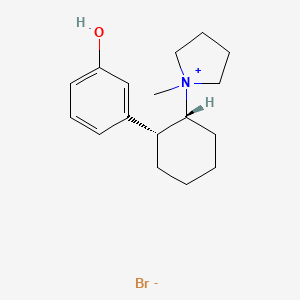
![(2S)-3-[4-[(2S)-2-amino-3-(4-hydroxyphenyl)propanoyl]phenyl]-N-[2-[[(2R)-2-aminopropanoyl]amino]acetyl]-2-[2-[hydroxy(methyl)amino]propyl-methylamino]propanamide](/img/structure/B1680346.png)
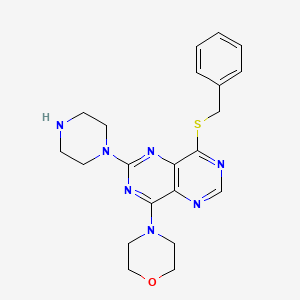
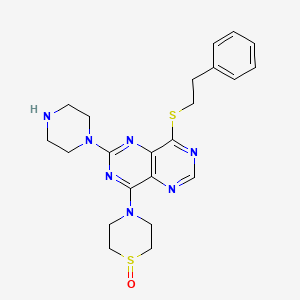
![Tert-butyl 12-ethynyl-8-methyl-9-oxo-2,4,8-triazatricyclo[8.4.0.0^{2,6}]tetradeca-1(14),3,5,10,12-pentaene-5-carboxylate](/img/structure/B1680352.png)
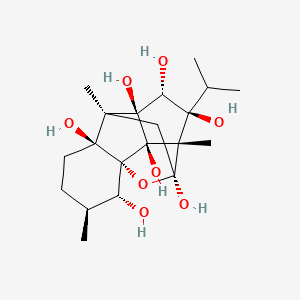

![(4R)-4-[(3S,5S,7R,8R,9S,10S,12S,13R,14S,17R)-7,12-dihydroxy-10,13-dimethyl-3-[[(4R)-4-[(3S,5S,7R,8R,9S,10S,12S,13R,14S,17R)-3,7,12-trihydroxy-10,13-dimethyl-2,3,4,5,6,7,8,9,11,12,14,15,16,17-tetradecahydro-1H-cyclopenta[a]phenanthren-17-yl]pentanoyl]amino]-2,3,4,5,6,7,8,9,11,12,14,15,16,17-tetradecahydro-1H-cyclopenta[a]phenanthren-17-yl]pentanoic acid](/img/structure/B1680357.png)
